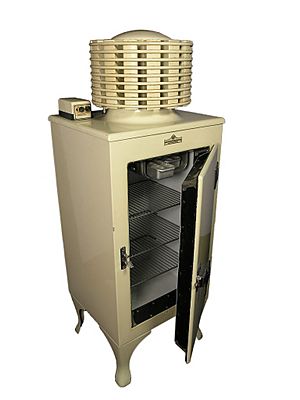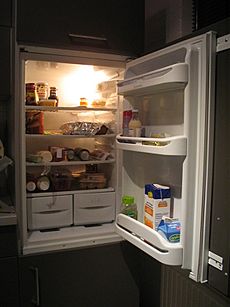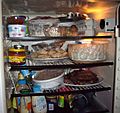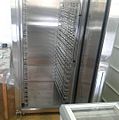Refrigerator facts for kids
A refrigerator is a machine that keeps things cold. People often call it a fridge or an icebox. Most fridges in homes are kept at about 4-5 degrees Celsius (around 40 degrees Fahrenheit). We put food and drinks inside to keep them cold and fresh for a longer time. A refrigerator works like a heat pump. It takes heat from the air inside the fridge and moves that heat to the air outside. An electric motor usually powers this heat pump.
Before electric fridges, people used ice boxes. These boxes didn't use electricity; they were filled with ice to keep things cold until the ice melted. You might still see smaller versions, often called coolers, used for camping trips. Large iceboxes were common before electricity was widely available.
Today, most modern refrigerators come in many different colours, but white is still very common. Smaller fridges are also popular, especially in hotels and college dorm rooms.

Contents
What is a Freezer?
A freezer is a special kind of refrigerator that stores food at very cold, freezing temperatures. Inside a freezer, the temperature is usually around -18 degrees Celsius (0 degrees Fahrenheit). Freezers are found in homes, as well as in businesses and factories. When food is kept in a freezer, it can stay safe and good for much longer than if it were stored at room temperature.
In homes, a freezer can be a separate part of a refrigerator, or it can be a completely separate appliance. Most home freezers keep temperatures between -23 to -18 degrees Celsius (-9 to 0 degrees Fahrenheit). Some special freezers can get even colder, down to -34 degrees Celsius (-29 degrees Fahrenheit) or lower. It's harder for regular home refrigerators to get much colder than -23 degrees Celsius because they share the same cooling system for both the fridge and freezer parts.
Most home freezers stand upright, looking similar to refrigerators. Some freezers are shaped like a chest and open from the top. Many new upright freezers even have an ice dispenser built into their door. Commercial freezers, like those in stores, often stand upright and have glass doors so shoppers can see what's inside.
How Did Refrigerators Develop?
Early Ways to Keep Things Cold
For a very long time, people have found ways to keep food cool. Long ago, in ancient Persia, people built special structures called Yakhchāls. These were large, domed buildings with thick walls and wind catchers that helped keep underground storage spaces cool, like an early form of air conditioning.
Before electric refrigerators, people used icehouses and iceboxes. These buildings were often built near lakes or filled with snow and ice in winter. They were very common for keeping food cool for most of the year. Even today, people might use natural methods, like putting drinks in cold stream water or keeping milk outdoors in winter, to keep them fresh.
The Invention of Artificial Cooling
The idea of making cold artificially started to grow. In 1755, a Scottish professor named William Cullen designed a small machine that could make things cold. He used a pump to make a special liquid called diethyl ether boil, which took heat away from the air around it. This even made a tiny bit of ice!
In 1805, American inventor Oliver Evans described a way to make ice using a closed system. Later, in 1834, Jacob Perkins built the first working system that could continuously make things cold using a process called vapor-compression.
An Australian named James Harrison built the first practical vapor-compression system in 1856. He made a machine that produced ice in 1851 and then started selling commercial ice-making machines in 1854. His machines were used in breweries and meat factories.
In 1859, Ferdinand Carré from France developed the first gas absorption refrigeration system. This system used ammonia gas dissolved in water. Later, in 1876, Carl von Linde improved how gases could be turned into liquids, which made it possible to use gases like ammonia and sulfur dioxide as coolants in refrigerators.
Refrigerators for Businesses and Homes
Large refrigerators and freezers for businesses were used for about 40 years before home models became common. These early commercial units used gases like ammonia or sulfur dioxide. Sometimes, these gases could leak, which made them unsafe for homes.
Practical refrigerators for homes started appearing around 1915. They became more popular in the United States in the 1930s as their prices dropped. Also, new, safer coolants like Freon-12 were introduced. However, Freon-12 was later found to harm the ozone layer, so it was banned in new refrigerators in 1994. A safer replacement, R-134a, has been used since 1990.
A common type of commercial refrigerator is the glass-fronted cooler for drinks. These are designed to handle many drinks and frequent door openings, so they have strong cooling systems.
Refrigerators for Homes
In 1913, Fred W. Wolf invented refrigerators for home use. His early models were units placed on top of an ice box. In 1914, Nathaniel B. Wales came up with an idea for a practical electric refrigeration unit, which later led to the Kelvinator brand.
In 1916, Alfred Mellowes invented a self-contained refrigerator with the compressor at the bottom. His company was later bought by William C. Durant, who started the Frigidaire company to make refrigerators in large numbers. In 1918, Kelvinator introduced the first refrigerator with automatic controls.
Baltzar von Platen and Carl Munters from Sweden invented the absorption refrigerator in 1922. This design became very successful and was sold by Electrolux.
Early home refrigerators often had the noisy mechanical parts, like the motor and compressor, installed in a basement or another room, while the cold box was in the kitchen. A 1922 model with a wooden cold box, water-cooled compressor, and an ice cube tray cost $714. (To compare, a 1922 Ford Model T car cost about $476.) By 1923, Kelvinator sold 80% of electric refrigerators. That same year, Frigidaire introduced the first all-in-one unit.
The General Electric "Monitor-Top" refrigerator, introduced in 1927, became very popular. People called it that because it looked like the gun turret on the warship USS Monitor. The compressor, which got very hot, was placed on top of the cabinet and covered by a decorative ring. Over a million of these units were made. These refrigerators used coolants like sulfur dioxide or methyl formate, which could be harmful if they leaked.
The introduction of Freon in the 1920s made refrigerators safer and helped the market grow in the 1930s. Separate freezers, often called "deep freezes," became common in the 1940s, but they weren't mass-produced for homes until after World War II. The 1950s and 1960s brought new features like automatic defrosting and automatic ice making. In the 1970s and 1980s, more energy-efficient refrigerators were developed, even though environmental concerns led to the ban of Freon.
Refrigerator Styles and Colors
In the early 1950s, most refrigerators were white. But from the mid-1950s onwards, designers started adding color to fridges. In the late 1950s and early 1960s, soft pastel colors like turquoise and pink were popular. Some models even had a shiny, brushed chrome look. In the late 1960s and through the 1970s, earth tone colors like Harvest Gold and Avocado Green were fashionable. In the 1980s, black became popular. By the late 1990s, stainless steel became very trendy and remains so today.
Images for kids
See also
 In Spanish: Refrigerador para niños
In Spanish: Refrigerador para niños














